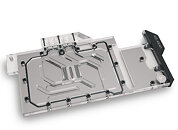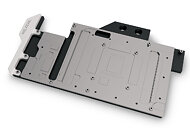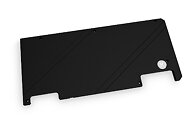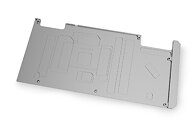Sunday, September 20th 2020

EK Water Blocks for ROG Strix NVIDIA RTX 30 Series Graphics Cards Now Available
EK, the leading computer cooling solutions provider, is ready to offer its premium high-performance GPU water block for ASUS ROG Strix edition NVIDIA GeForce RTX 30 Series graphics cards. This huge new water block is named EK-Quantum Vector Strix RTX 3080/3090 D-RGB, and it is very important to keep in mind that it's meant only for the ROG Strix graphics cards.
"For years now, each generation of ROG Strix edition full-cover water blocks was utilizing bridge covers to channel coolant over the tall capacitors in the VRM zone. This time around, the layout of the PCB allowed us to make a water block without a stainless-steel bridge cover, making the entire coolant flow path visible. Our engineering team also went the distance on the copper cold plate design that now extends over almost the full length of the PCB," said Edvard König, the founder of EK.An EK Water Block for ROG Strix GeForce RTX 3080 and 3090 Graphics Cards
The new water block has a much bigger purpose-designed 126 mm wide and 237 mm long copper base to cover and cool all key components on the GPU's printed circuit board. This gives the water block advantage on the market of having a clean design, showing off all of the cooling liquid, and cooling all of the necessary components, including all chokes on the input rail.
The EK-Quantum Vector Strix RTX 3080/3090 water block is compatible with ROG Strix RTX 3080 and 3090 graphics cards. This Vector water block actively cools the GPU, top-facing VRAM, MOSFETs in the VRM section, PWM controller, and all chokes, including the ones in the input power rail. By using such a design that is in contact with every single inductor on the PCB, the chances of any potential coil whine are minimized.
These newly developed Strix water blocks feature clean, symmetrically shaped optimized flow paths that reduce hydrodynamic instabilities and vortexing (dead spots) inside of them, and it's not using bridge covers like former EK Strix water blocks, which is the reason the entire coolant flow path is now visible.
An Open Split-Flow cooling engine design is implemented, which proved to be a superior solution for GPU water blocks. It is characterized by low hydraulic flow restriction, meaning it can be used with weaker water pumps or pumps running on low-speed settings, and still achieve top performance. The jet plate and fin structure geometry have been optimized to provide even flow distribution with minimal losses and optimal performance when used in any given coolant flow orientation, unlike some products that are currently available on the market.
Fin array is populated by 28 microfins with 0.6 mm wide microchannels that provide optimal cooling performance, without unnecessary flow restrictions or clogging hazards.
The base of the water block is CNC-machined out of nickel-plated electrolytic copper, while its top is CNC-machined either out of glass-like cast Acrylic or durable black POM acetal. The 2nd generation Vector GPU water blocks also feature plexi and acetal terminals that match the top cover material. The watertight sealing is ensured by high-quality EPDM O-rings, while brass standoffs are already pre-installed and allow for a safe and easy installation procedure.
D-RGB Lighting on the EK-Quantum Vector Strix RTX 3080/3090 D-RGB
The aesthetic end-piece is housing the addressable D-RGB LED strip. This water block boasts a total of 12 individually addressable RGB LEDs, and it is compatible with popular RGB sync technologies from all major motherboard manufacturers. The arrow marking on the 3-pin D-RGB LED connector is to be aligned with the +5V marking on the D-RGB (addressable) header.
Backplate for the Strix RTX 3080/3090 Water Block
EK recommends the purchase of a retention backplate, which improves the overall aesthetics of your graphics cards, and also provides additional passive cooling for the GPU core, VRAM on the 3090 cards, and backside of the printed circuit board VRM section.
Upcoming NVIDIA RTX 30 Series Water Blocks
There are probably a lot of questions about other RTX 30 Series water blocks as well - for the AIB cards and Founders Edition especially. EK water blocks for EVGA XC3 and ASUS TUF Series graphics cards will follow in a matter of weeks, while the Founders Edition water blocks will take a bit longer since EK is preparing something really special for those graphics cards.
Availability and Pricing
The EK-Quantum Vector Strix RTX 3080/3090 full-cover water blocks and backplates are made and assembled in Slovenia, Europe, and are available for pre-order through the EK Webshop. The water blocks and backplates are expected to ship out mid-October, or possibly even sooner. In the table below you can see the manufacturer suggested retail price (MSRP).
Current Compatibility List for EK-Quantum Vector Strix RTX 3080/3090
"For years now, each generation of ROG Strix edition full-cover water blocks was utilizing bridge covers to channel coolant over the tall capacitors in the VRM zone. This time around, the layout of the PCB allowed us to make a water block without a stainless-steel bridge cover, making the entire coolant flow path visible. Our engineering team also went the distance on the copper cold plate design that now extends over almost the full length of the PCB," said Edvard König, the founder of EK.An EK Water Block for ROG Strix GeForce RTX 3080 and 3090 Graphics Cards
The new water block has a much bigger purpose-designed 126 mm wide and 237 mm long copper base to cover and cool all key components on the GPU's printed circuit board. This gives the water block advantage on the market of having a clean design, showing off all of the cooling liquid, and cooling all of the necessary components, including all chokes on the input rail.
The EK-Quantum Vector Strix RTX 3080/3090 water block is compatible with ROG Strix RTX 3080 and 3090 graphics cards. This Vector water block actively cools the GPU, top-facing VRAM, MOSFETs in the VRM section, PWM controller, and all chokes, including the ones in the input power rail. By using such a design that is in contact with every single inductor on the PCB, the chances of any potential coil whine are minimized.
These newly developed Strix water blocks feature clean, symmetrically shaped optimized flow paths that reduce hydrodynamic instabilities and vortexing (dead spots) inside of them, and it's not using bridge covers like former EK Strix water blocks, which is the reason the entire coolant flow path is now visible.
An Open Split-Flow cooling engine design is implemented, which proved to be a superior solution for GPU water blocks. It is characterized by low hydraulic flow restriction, meaning it can be used with weaker water pumps or pumps running on low-speed settings, and still achieve top performance. The jet plate and fin structure geometry have been optimized to provide even flow distribution with minimal losses and optimal performance when used in any given coolant flow orientation, unlike some products that are currently available on the market.
Fin array is populated by 28 microfins with 0.6 mm wide microchannels that provide optimal cooling performance, without unnecessary flow restrictions or clogging hazards.
The base of the water block is CNC-machined out of nickel-plated electrolytic copper, while its top is CNC-machined either out of glass-like cast Acrylic or durable black POM acetal. The 2nd generation Vector GPU water blocks also feature plexi and acetal terminals that match the top cover material. The watertight sealing is ensured by high-quality EPDM O-rings, while brass standoffs are already pre-installed and allow for a safe and easy installation procedure.
D-RGB Lighting on the EK-Quantum Vector Strix RTX 3080/3090 D-RGB
The aesthetic end-piece is housing the addressable D-RGB LED strip. This water block boasts a total of 12 individually addressable RGB LEDs, and it is compatible with popular RGB sync technologies from all major motherboard manufacturers. The arrow marking on the 3-pin D-RGB LED connector is to be aligned with the +5V marking on the D-RGB (addressable) header.
Backplate for the Strix RTX 3080/3090 Water Block
EK recommends the purchase of a retention backplate, which improves the overall aesthetics of your graphics cards, and also provides additional passive cooling for the GPU core, VRAM on the 3090 cards, and backside of the printed circuit board VRM section.
Upcoming NVIDIA RTX 30 Series Water Blocks
There are probably a lot of questions about other RTX 30 Series water blocks as well - for the AIB cards and Founders Edition especially. EK water blocks for EVGA XC3 and ASUS TUF Series graphics cards will follow in a matter of weeks, while the Founders Edition water blocks will take a bit longer since EK is preparing something really special for those graphics cards.
Availability and Pricing
The EK-Quantum Vector Strix RTX 3080/3090 full-cover water blocks and backplates are made and assembled in Slovenia, Europe, and are available for pre-order through the EK Webshop. The water blocks and backplates are expected to ship out mid-October, or possibly even sooner. In the table below you can see the manufacturer suggested retail price (MSRP).
Current Compatibility List for EK-Quantum Vector Strix RTX 3080/3090
- ASUS ASUS ROG Strix RTX 3090 24G Gaming
- ASUS ASUS ROG Strix RTX 3080 10G Gaming
- ASUS ASUS ROG Strix RTX 3080 10G Gaming OC
- ASUS ASUS ROG Strix RTX 3090 24G Gaming OC





10 Comments on EK Water Blocks for ROG Strix NVIDIA RTX 30 Series Graphics Cards Now Available
Hope the prices won't be that special...
I like EK blocks for their aesthetics but function wise I would rather wait for Watercool who are considering an active Backplate aka sandwich cooler. Aquacomputer might do the same.
thermalbench.com/2017/04/26/aqua-computer-kryographics-pascal-1080/5/
So being actively cooled by the coolant is what I meant.
But in Case of Ampere I could also imagine actual water channels letting liquid flow over the backplate. Which at this point wouldn't be a simple backplate anymore but a second, smaller block on the backside of the card. Obviously more complicated and expensive.
Hence why I mentioned a fan. ;)